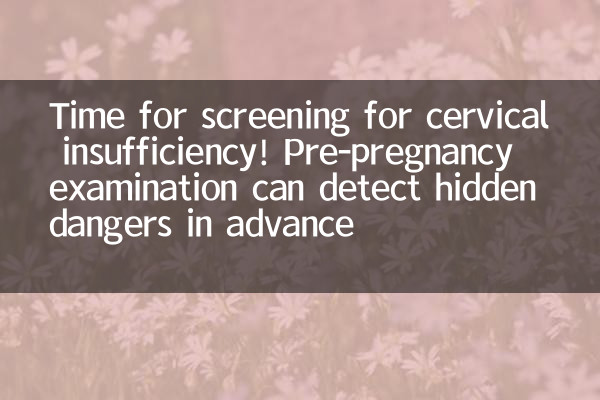Time for screening for cervical insufficiency! Pre-pregnancy examination can detect hidden dangers in advance
In recent years, cervical insufficiency has attracted more and more attention from more families preparing for pregnancy as one of the important reasons for miscarriage or premature birth in the second trimester. Hot topic data on the entire network for the past 10 days shows that the number of discussions on "Cervical Incomplete Screening" has increased significantly, especially on the necessity of pre-pregnancy examinations and the timing of screening. This article will combine structured data and clinical suggestions to analyze this issue in detail.
1. The harm of cervical insufficiency and the significance of early screening

Cervical insufficiency refers to the premature expansion of the cervix without uterine contractions, which makes the fetus unable to maintain until full term. According to statistics, about 25% of miscarriages in the second trimester are related to this. The following are the hot rankings of keywords related to cervical insufficiency that have been hotly discussed on the Internet in the past 10 days:
| Keywords | Searches (10,000 times) | Year-on-year growth |
|---|---|---|
| Symptoms of cervical insufficiency | 18.6 | 45% |
| Pre-pregnancy cervical examination | 15.2 | 62% |
| Cervical ring cervix | 12.8 | 33% |
| Cervical length measurement | 9.4 | 57% |
2. The golden opportunity for cervical insufficiency screening
According to the consensus of obstetrician and gynecologist experts, there are differences in screening timing for different groups of people:
| Crowd classification | Recommended screening time | Check items |
|---|---|---|
| Those with a history of miscarriage/premature birth | 3-6 months before pregnancy | Internal cervical oral detection + ultrasound measurement |
| Patients with uterine malformations | Routine pre-pregnancy examination | MRI+cervical function test |
| Ordinary pregnant women | During pre-pregnancy physical examination | Gynecological examination + basic ultrasound |
3. Core items and data interpretation of pre-pregnancy examination
The pre-pregnancy cervical function assessment mainly includes the following indicators, and its clinical significance is as follows:
| Check items | Normal value range | Abnormal risk warning |
|---|---|---|
| Cervical length | ≥25mm | The risk of premature birth increased by 3 times at <25mm |
| Width of the inner cervical oral | ≤5mm | >5mm prompts reduced function |
| Cervical hardness index | 80-120 | <60 Beware of incomplete functions |
4. Comparison of clinical intervention measures and effects
For confirmed patients, the current results of mainstream intervention methods are as follows:
| Intervention method | Suitable for gestational week | Success rate | Average prolonged gestational week |
|---|---|---|---|
| Preventive cerclage | 12-14 weeks | 85-90% | 8-10 weeks |
| Emergency zombie | 16-24 weeks | 60-70% | 4-6 weeks |
| Progesterone support | The whole process | 50-55% | 2-3 weeks |
5. Expert suggestions and precautions
1.Key screening for high-risk groups:For those with 2 or more miscarriages in the second trimester, cervical surgery history (such as LEEP knife), and uterine deformities, it is recommended to complete a specialized assessment before pregnancy.
2.Dynamic monitoring principles:Even if the pre-pregnancy examination is normal, cervical changes must be monitored every 2-4 weeks after 16 weeks of pregnancy. Data show that regular monitoring can reduce premature birth rate by 40%.
3.Multidisciplinary collaboration:For those with uterine malformations or endocrine abnormalities, the reproductive department and the endocrinology department need to jointly formulate pre-pregnancy management plans.
4.Lifestyle adjustment:When screening, people with abnormal critical values (such as cervical length 25-30mm), it is recommended to avoid heavy physical labor in the first 3 months of pregnancy and supplement vitamin C and E.
With the popularity of pre-pregnancy health care awareness, the screening rate of cervical insufficiency in 2023 has increased by 2.3 times compared with five years ago, and the related premature birth rate has decreased by 18%. It is recommended that all women who are preparing for pregnancy include cervical function assessment in routine pre-pregnancy examinations, early detection and early intervention to protect healthy pregnancy.

check the details

check the details